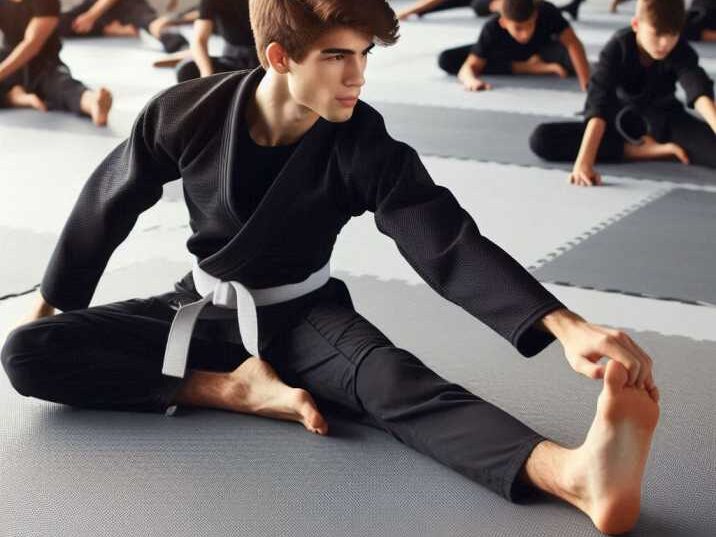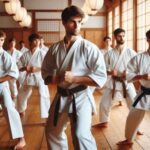Mixed Martial Arts (MMA) is an exciting and powerful combination of fighting styles. MMA training can build confidence, improve focus, and teach discipline—important school, sports, and everyday life skills! This guide will show you how to teach yourself mixed martial arts. whether you’re practising at home or in a local gym.
In this article, we’ll walk through key MMA techniques and tips that are beginner-friendly and easy to learn. You’ll also find exercises that build your strength, focus, and coordination, which are all super important in MMA. Let’s dive into the exciting world of mixed martial arts!

What is Mixed Martial Arts?
Table of Contents
Mixed Martial Arts, or MMA, is a sport that combines techniques from different fighting styles like boxing, wrestling, Brazilian Jiu-Jitsu, and Muay Thai. This makes MMA unique because it includes skills from both striking and grappling martial arts.
Learning MMA on your own might seem challenging, but with consistent practice and focus on safety, it’s possible to make great progress.
Getting Started: Training Basics
1. Create a Safe Training Space
Before practising any moves, set up a safe training space. Clear an area in a room, basement, or backyard where you have plenty of room to move. Here’s what you need:
- Soft flooring or a mat to prevent injuries
- Protective gear like gloves, mouthguards, and shin guards for safety
- A mirror if possible, to check your form
This space should be dedicated to your MMA practice and free from distractions.
2. Focus on Warming Up
Warming up is essential for preventing injuries and preparing your body for exercise. A proper warm-up includes:
- Jumping jacks (3 minutes)
- Arm and leg stretches to improve flexibility
- Shadowboxing to increase heart rate and get into a fighting mindset
Make sure to warm up before every session, as this keeps your muscles and joints ready for action.
3. Learn Basic Strikes
MMA striking combines moves from boxing and kickboxing. Some essential strikes include:
- Jab: A quick punch with your lead hand. This is great for keeping your opponent at a distance.
- Cross: A powerful punch with your rear hand, often used to create openings.
- Hook: A circular punch aimed at the side of the opponent’s head.
- Roundhouse Kick: A strong, swinging kick that uses the shin or foot to strike.
- Knee Strike: Lift your knee to hit the opponent’s body, usually aimed at the chest or stomach.
Practising these moves regularly can help develop strong muscle memory, which is key to becoming skilled in MMA.
Practice with Shadowboxing
Shadowboxing is like imagining you’re sparring with someone. It’s a way to practice these moves without needing a partner. Shadowbox in front of a mirror to correct your form and improve coordination.
Building Strength and Endurance
In MMA, strength and endurance are essential. Here are some exercises that help you build these qualities:
4. Bodyweight Exercises
You don’t need weights to get strong! Bodyweight exercises work great and can be done anywhere.
- Push-Ups: Build arm and shoulder strength
- Squats: Strengthen your legs and core
- Sit-Ups: Develop abdominal strength, which is essential for stability
- Burpees: A full-body exercise that builds endurance
Repeat these exercises in sets to improve your stamina and overall strength.
5. Practicing Basic Grappling Moves
For self-taught MMA, it’s best to start with fundamental grappling moves like:
- Sprawling: This is a defensive move to stop an opponent from taking you down.
- Single-Leg Takedown: A technique for bringing an opponent down by grabbing one of their legs.
- Rear-Naked Choke: A common submission technique that requires caution when practising.
It’s wise to practice these moves on a soft surface, like a wrestling mat, and use a training partner only if you both feel comfortable.
Focus and Discipline in Training
6. Set Goals and Stay Consistent
Consistency is key in any martial art. Set a training schedule with specific goals, like:
- Practising three times a week
- Mastering one technique per week
- Gradually increasing workout intensity
By staying disciplined and following your schedule, you’ll see steady improvement.
Safety First: Protecting Yourself While Training
7. Avoid Injuries
Since you’re training alone, keeping yourself safe is a top priority. Here are some tips:
- Warm-Up and Cool-Down: Always stretch before and after practice.
- Start Slow: Focus on learning the correct form before adding speed or power.
- Wear Protective Gear: Gloves, shin guards, and mouthguards help prevent injuries.

Table of Information: Key Components of Self-Taught MMA
| MMA Aspect | Description |
|---|---|
| Striking Techniques | Punches, kicks, elbows, knees from styles like boxing and Muay Thai |
| Grappling Techniques | Punches, kicks, elbows, and knees from styles like boxing and Muay Thai |
| Physical Conditioning | Exercises to build strength, endurance, and flexibility |
| Focus and Discipline | Staying dedicated to training and improving concentration |
| Safety Practices | Warm-ups, stretching, and using protective gear for injury prevention |
Conclusion
Learning MMA by yourself can be an exciting journey. It takes discipline, focus, and patience to master the techniques. Safety comes first, so always warm up, wear protective gear, and practice slowly until you build confidence. Following these tips and committing to regular practice, you can become skilled in MMA even without formal classes. So, set up a safe space, stay motivated, and enjoy the journey of teaching yourself mixed martial arts!
FAQs About Self-Taught MMA
- Can I learn MMA without a partner?
Yes, you can start with solo drills and shadowboxing. Once you master the basics, a partner can help with sparring. - Is MMA training safe for kids?
With proper safety gear and supervision, basic MMA techniques can be safe. - How long does it take to get good at MMA?
It depends on your dedication. Practising consistently will lead to faster improvement. - What equipment do I need?
Basic gear includes gloves, mouthguards, shin guards, and a soft mat. - Can I learn grappling alone?
Some drills, like sprawling, can be done solo. For advanced moves, it’s best to have a partner.


